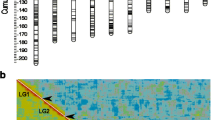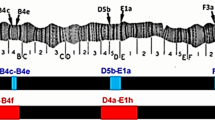Summary
Natural populations of Drosophila nasuta are polymorphic for many gene arrangements. Two non-overlapping inversions of the third chromosome, III-2 and III-35, are most common and display extreme linkage disequilibrium. Six randomly mating laboratory stocks, each founded by one gravid female heterozygous in coupling for both III-2 and III-35, were observed after 32 generations. Significant linkage disequilibrium was observed in all stocks. Recombinants were found in only two stocks. The absence of effective recombination in some stocks and its presence in others might be due to different genotypic backgrounds. We suggest that natural selection, influencing recombination rates in several ways, and intrachromosomal epistasis between the two inversions were the main factors for the maintenance of linkage disequilibrium in D. nasuta.
Similar content being viewed by others
References
Bodmer WF, Parsons PA (1962) Linkage and recombination in evolution. Adv Genet 11:1–100
Dobzhansky TH (1970) Genetics of the evolutionary process. Columbia University Press, New York
Dobzhansky TH, Spassky B (1960) Release of genetic variability through recombination. V. Breakup of synthetic lethals by crossing over in Drosophila pseudoobscura. Zool Jahrb 88:57–66
Fisher RA (1930) The genetical theory of natural selection. Clarendon Press, Oxford
Hill WG (1974) Estimation of linkage disequilibrium in randomly mating populations. Heredity 33:229–239
Kitagawa O, Wakahama KI, Fuyama Y, Simada Y, Takanasi E, Halsumi M, Uwabo M, Mita Y (1982) Genetic studies of the Drosophila nasuta subgroup, with notes on distribution and morphology. Jpn J Genet 57:113–141
Kumar A, Gupta JP (1986a) Inversion polymorphism in Drosophila nasuta. Dros Inf Serv 63:78–80
Kumar A, Gupta JP (1986b) Linkage disequilibrium between two naturally occurring gene arrangements of Drosophila nasuta. Heredity 57:1–4
Lamb CG (1914) Diptera: Heteroneuridae, Ortalidae, Milichidae, of the Seychelles. Trans Linn Soc (London) 16:307–372
Lerner IM (1954) Genetic homeostasis. Oliver and Boyd, Edinburgh
Levitan M (1958) Non-random associations of inversions. Cold Spring Harbor Symp Quant Biol 23:251–268
Lewontin RC (1964) The interaction of selection and linkage. I. General considerations: heterotic models. Genetics 40:49–67
Sperlich D, Feuerbach-Mravlag H (1974) Epistatic gene interaction, crossing over and linked and unlinked inversions in Drosophila subobscura. Evolution 28:67–75
Strickberger MW (1962) Experiments in genetics with Drosophila. Wiley and Suns, New York London
Wallace B (1968) Topics in population genetics. WW Norton, New York
Author information
Authors and Affiliations
Additional information
Communicated by K. Sittmann
Rights and permissions
About this article
Cite this article
Kumar, A., Gupta, J.P. Linkage disequilibrium in laboratory populations of Drosophila nasuta . Theoret. Appl. Genetics 75, 902–904 (1988). https://doi.org/10.1007/BF00258051
Received:
Accepted:
Issue Date:
DOI: https://doi.org/10.1007/BF00258051




